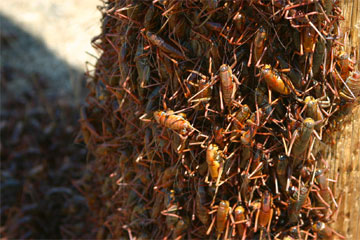Social interactions influence cannibalistic behavior among migratory bands of crickets, finds a new study published in the Public Library of Science. Cannibalism in turn is a major driving force behind the nature and direction of cricket swarms.
The study, which focused on the Mormon cricket, is one of the first to shed light on the reasons behind the cannibalistic practices of an invertebrate species.
Mormon crickets are a type of flightless katydid which occasionally assemble in swarms which can stretch to over 10km in length, consist of up to several million individuals, and are capable of marching 2km/day. While until recently poorly understood, the mechanisms driving the cohesion of these massive swarms are now thought to be predator evasion and resource acquisition. Radio telemetry conducted on these swarms indicated that individuals which stray from the swarm are at a substantially higher risk of predation.
Another characteristic of these groups is that in addition to consuming every bit of vegetation in their path, the crickets often eat each other. The reason behind this behavior is obvious; huge, concentrated numbers of crickets require huge, concentrated amounts of food. If the landscape doesn’t provide it, a fellow cricket will. However, how these cannibals decide who to eat has until now been a mystery. The cognitive ability required to carry out this kind of relatively complex decision-making was formerly thought to be beyond the capability of insects who were largely assumed to act randomly and without rationale. But in the past decade there’s been a flurry of research which has indicated that many species of insects are capable of utilizing social information. This study indicates that the Mormon cricket has a place on that list.
 Photo © Katie Madonia |
The researchers observed Mormon cricket swarms in Utah, and conducted experiments which examined various factors such as sex, spatial orientation, and group density. They found that individuals which were not oriented in the direction of the flow were more likely to be attacked and eaten by other crickets than those whose motion was parallel with the rest of the swarm. Females were more likely than males to initiate an attack, however males were more likely to kill their targets. Targeted individuals which were surrounded by nine or more crickets were more likely to be attacked than those which were not heavily surrounded. Individuals which had halted their march were much more likely to be attacked than those which were mobile.
This study supports claims that cannibalistic behavior influences the movement of a swarm as observations indicated that “going with the flow” made it less likely that an individual would be cannibalized, even if population density encouraged cannibalism. In other words, crickets would rather suffer the risk of being eaten by each other than hazard a chance outside a swarm.
Related articles